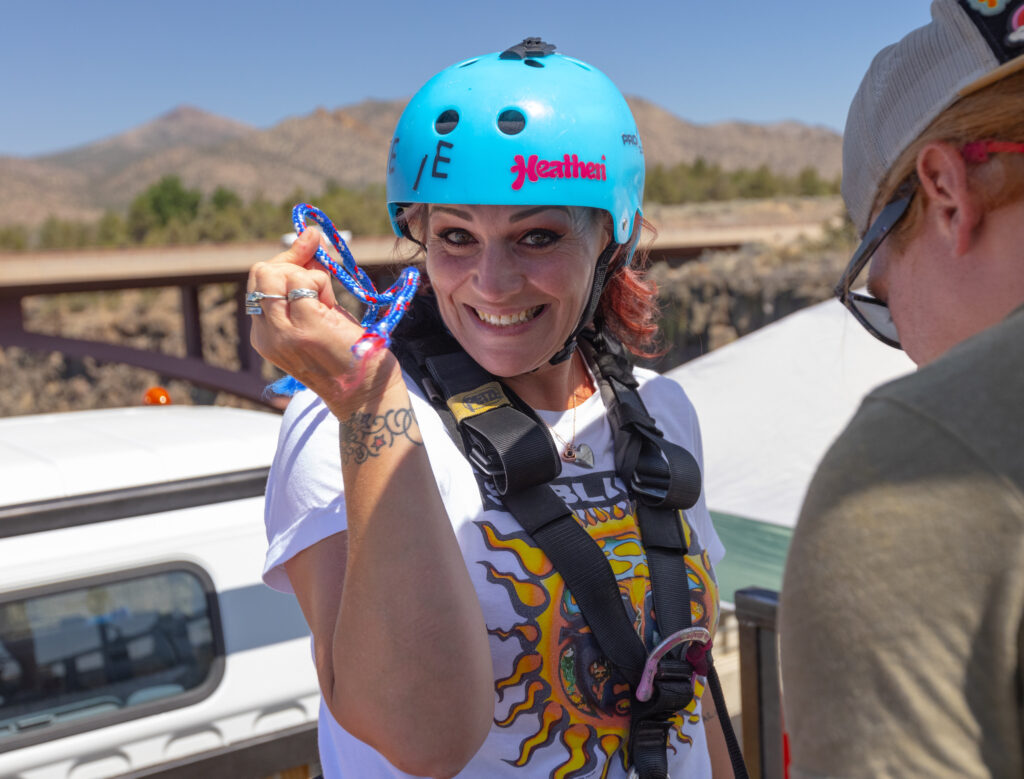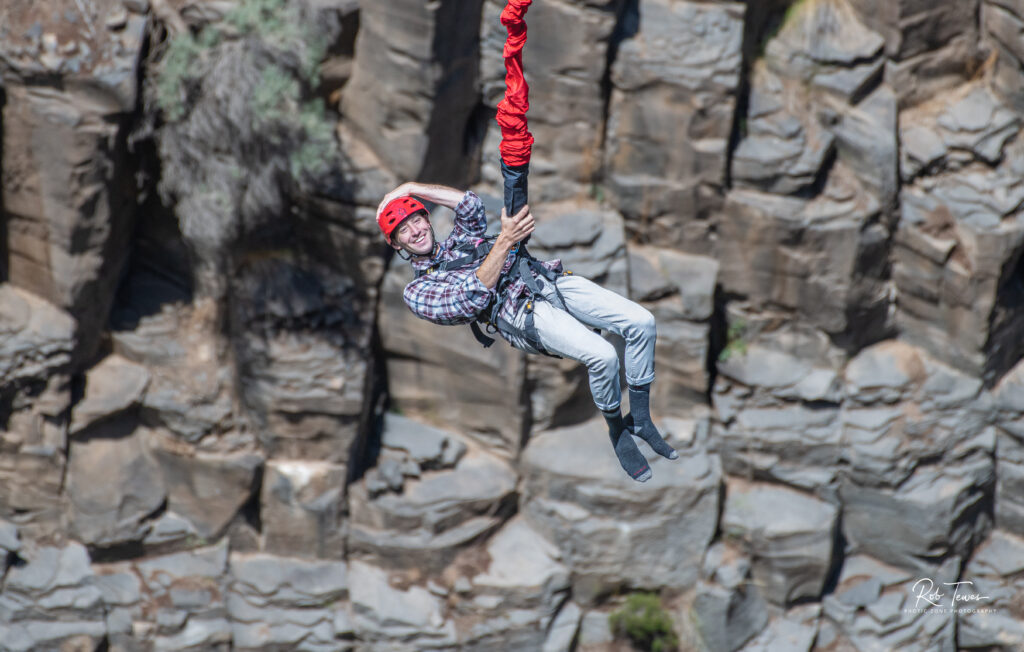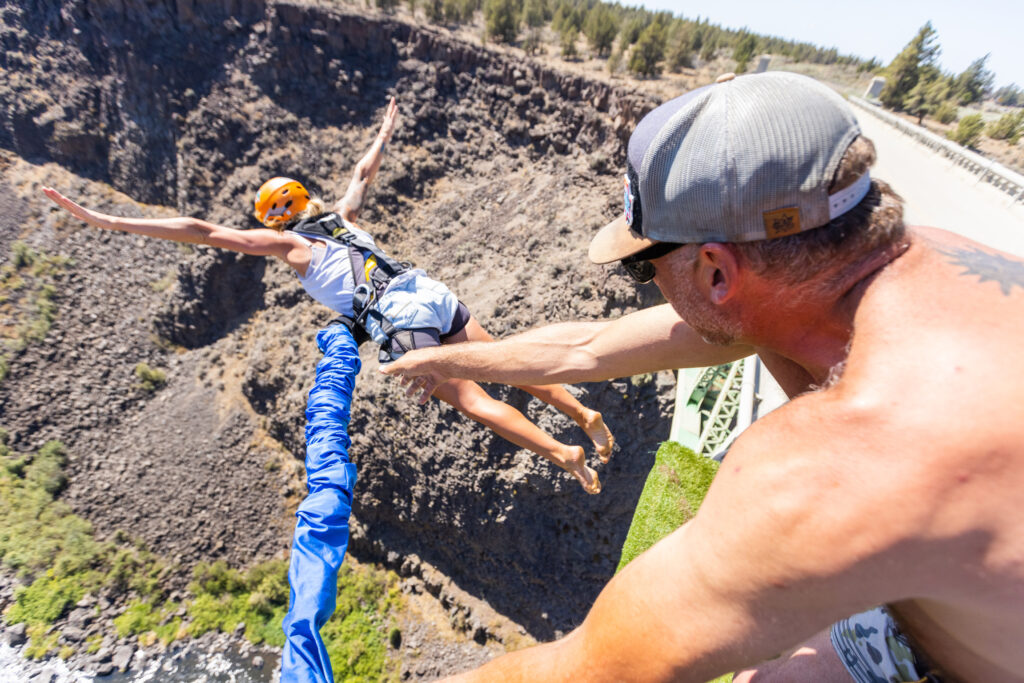
Welcome to today’s article where you will find out the answer to one of the most burning questions asked by jumpers, “What does bungee jumping feel like?” Bungee jumping is an unforgettable adventure and is like nothing else, and we’re here to take you on a journey to discover the incredible feelings you will experience.
How Bungee Jumping Feels
Bungee jumping is like taking a leap into the unknown, where you forgo solid ground for a few heart-pounding seconds of pure exhilaration. Let’s explore the amazing sensations that accompany this daring sport.
Before the Jump: Your Nerves
Before the jump, it’s entirely normal to feel a mix of excitement and nervousness. We always say on the bridge, “If you’re not scared or nervous, then there’s probably something wrong with you. Bravery is not one who does not feel afraid, but one who conquers that fear.” Remember, feeling nervous is perfectly normal and we encourage jumpers to embrace it. It’s a sign that you’re uncomfortable, but on the other side of that challenge is conquering fear or doubt that only exists in your head. So, embrace that nervous energy and use it to fuel your courage.
The Leap into the Unknown
Picture yourself standing on the edge of a towering platform. Your heart races as you gaze at the open sky and the abyss below. It’s a bit like standing on the edge of a diving board at the pool, but multiple times higher. The wind blows through your hair, and the world seems both distant and surreal. Your legs feel like jelly, and your mind is a mix of fear and excitement. The choice is yours: to leap or not to leap. And then, you commit – you jump.
The Heart in Your Throat: The Initial Drop
As you leap into the void, that feeling in your stomach is like the big drop on a rollercoaster, but it lasts much longer. It’s as if your heart leaps into your throat, and you briefly forget to breathe. The sensation is electrifying, and your body wants to defy gravity as you plummet. This is where many people flail and flap their arms and legs as if they were a bird that can fly away. Sorry, but you can’t fly. At the same time a burst of pure adrenaline shoots through you that leaves you breathless, and you can’t help but let out a scream (or squirm) from the lump in your throat.
The Incredible Sense of Freefall
During the initial seconds of your jump, you’re in freefall. It’s like a rock falling through the sky or a superhero in a movie. The ground is rushing towards you, and time seems to slow down. The sensation of weightlessness takes over, and you’re no longer bound by the laws of gravity. Wind rushes past your ears at what feels like a million miles per hour. It’s a feeling of pure freedom, unlike anything you’ve ever experienced.
The Stretch
As you freefall in a dive position, the cord will naturally start to slow down rapidly and it will rotate you forward until you are facing up looking back at the bridge. The stretch of the bungee cord can be described similarly to a rubber band. You will feel the tug of the cord on your harness and then enter into the rebound.
The Thrill of the Bungee Rebound
Just when you thought the adventure was over, the bungee rebounds, and you slingshot back in the air. It’s like the best trampoline jump you’ve ever had, but with the added excitement of being hundreds of feet above the ground. The rebound is thrilling and adds a different sensation to your bungee jump. You get another weightless second at the top of the rebound while swinging back and forth underneath the bridge.
Suspended in Mid-Air: Weightlessness and Euphoria
Then, as quickly as you fell, you’re suspended in mid-air, a few hundred feet above the bottom of ground. It’s as if you’re floating in mid air with the world far below. The harness and bungee cord support you, and you can look around and take in the breathtaking surroundings. The Crooked River Gorge and the majestic Cascade Mountains come into view with the bridge up above, creating a backdrop of stunning natural beauty that adds to the euphoria of the moment. Don’t forget to take it all in before you get pulled back up!
As we’ve discovered, bungee jumping is a mix of heart-pounding fear and exhilarating joy. But there’s more to the experience than just the feeling. Central Oregon Bungee Adventures provides the perfect backdrop for your jump. In the next section, we’ll explore the location that makes this adventure truly unforgettable.
The Location Matters
Bungee jumping isn’t just about the heart-pounding sensation; it’s also about the breathtaking location. Central Oregon Bungee Adventures is nestled in a spot that adds a touch of magic to your leap of faith.
Central Oregon’s Stunning Bungee Site
Our bungee site is located in the enchanting PS Ogden State Park, a place where nature’s beauty is on full display. It’s like stepping into a postcard, where you’re surrounded by lush greenery and the fresh scent of the outdoors. This park is the ideal setting for a bungee adventure, offering a peaceful escape from the hustle and bustle of everyday life.
Mesmerizing Views at the High Bridge
The centerpiece of our bungee jumping experience is the high bridge, an engineering marvel that spans the Crooked River Gorge. The view from here is nothing short of spectacular. Picture yourself standing on the edge of the bridge, ready to take the plunge, and gazing down at the meandering river hundreds of feet below. The feeling is both thrilling and humbling as you realize the sheer vastness of nature.
As you prepare to take your leap, you’ll be enveloped by the awe-inspiring landscapes of Central Oregon. The Crooked River Gorge stretches out below you, while the Cascade Mountains provide a majestic backdrop behind the train bridge that comes before it. It’s a visual feast for the senses, making your bungee jump not just an adventure but a true connection with nature’s magnificence.
In the next section, we’ll explore the timing of your bungee adventure. Planning your jump for the right season ensures you experience the magic of Central Oregon to the fullest. So, let’s dive into “Bungee Jumping Season” and learn when the best time is to take the plunge.
Bungee Jumping Season
Timing is everything when it comes to planning your bungee adventure. At Central Oregon Bungee Adventures, we want to make sure you experience the thrill of bungee jumping at the perfect time.
Planning Your Bungee Adventure at the Right Time
Before you gear up for your bungee jump, it’s crucial to consider the best time for your adventure. Our bungee season typically runs from May through October, and we’re ready to jump in various weather conditions, rain or shine. We don’t shy away from rain, and bungee jumping in the rain is a safe and secure experience as long as there’s no lightning.
However, it’s important to understand that the weather can impact your bungee jump experience. When planning your jump, especially during the spring and fall, keep in mind the conditions you might encounter.
For instance, if you choose to bungee jump in the rain, rest assured that it’s still safe and secure. You might feel a few raindrops during your descent, but the excitement of the freefall will quickly take over.
Bungee jumping in windy conditions can also affect your jump. The wind can alter your swing at the bottom, and the bungee cord might swing into you. Diving into windy conditions adds an extra element of unpredictability to your adventure, so be prepared to listen to instructors to best prepare for your jump.
Whatever weather conditions you choose to jump in, our team of professionals is here to ensure a safe experience. We constantly monitor the conditions, and we won’t hesitate to call off jumping or temporarily close if we feel the weather poses any safety risks. Your well-being is our top priority, and we’re committed to making your bungee jump an unforgettable and safe experience.
Managing Fear
It’s perfectly normal to have a mix of excitement and uneasiness when it comes to bungee jumping. We understand that facing your fears can be a challenge, but we’re here to help you through it. In this section, we’ll address common fears and provide tips to help you manage any anxiety you may have about taking the leap.
Addressing Common Fears
Fear of Heights: This is one of the most common fears people have when considering bungee jumping. Standing on the edge of the high bridge can be intimidating, but it’s important to remember that you’re securely harnessed and in the hands of professionals.
Fear of Falling: The sensation of falling is what makes bungee jumping exhilarating, but it can also be a source of fear. Rest assured, the bungee cord is designed to slow your fall and bring you back safely.
Fear of the Unknown: Bungee jumping is an adventure into the unknown, and it’s natural to fear the unexpected. However, our team is highly trained, and safety is our priority. They will guide you through the process and ensure a safe and thrilling experience.
Overcoming Anxiety: Tips for First-Time Jumpers
If you’re feeling anxious about your upcoming bungee jump, consider these tips to help ease your nerves:
Trust the Professionals: Our instructors are experienced and have helped countless jumpers face their fears. Trust in our expertise and guidance.
Focus on Your Breathing: Deep, slow breaths can help calm your nerves. Concentrate on your breath as you prepare to jump.
Visualize Success: Before you jump, visualize a successful and thrilling experience. This positive imagery can boost your confidence.
Bring a Supportive Friend: If you’re feeling nervous, consider bringing a friend along for moral support. Sharing the adventure can make it even more enjoyable.
Embrace the Fear: Recognize that fear is a natural part of bungee jumping. Embrace it, and let it add to the excitement.
With these tips and the support of our team, you’ll be better prepared to take the leap and experience the incredible sensation of bungee jumping. Facing your fears can lead to some of the most memorable moments of your life.
In the next section, we’ll answer some common questions about bungee jumping and provide additional insights to prepare you for your adventure.
Does Bungee Jumping Hurt?
One of the most common questions about bungee jumping is whether it hurts. It’s a valid concern, and in this section, we’ll delve into the physical sensations involved and dispel some misconceptions.
Bungee jumping is not inherently painful. The sensation you experience is a mixture of adrenaline, exhilaration, and a completely new experience for most people. The initial moments, such as the heart-pounding drop and the snapback, can be intense, but they are not painful. The bungee cord and harness are designed to provide a controlled and comfortable experience.
It’s essential to understand that while there may be a bit of discomfort from the harness or the sudden deceleration during the rebound, it’s not painful in an injury sense. Bungee jumping is designed to be a thrilling, enjoyable adventure, and safety measures are in place to ensure your well-being.
For a more detailed look at this topic, you can explore our article on “Does Bungee Jumping Hurt.” It provides a comprehensive explanation of the physical sensations involved in a bungee jump and addresses common concerns about any potential discomfort.
Conclusion
Bungee jumping is an adventure like no other, and we’ve gone over the thrilling sensations, the breathtaking location, and addressed bungee jumping causing pain so you can be prepared for your leap of a lifetime with us. With the guidance of our expert team, your safety is ensured, and your fears can be conquered.
Remember, bungee jumping is not just about the exhilaration of freefall but also about challenging yourself while embracing the beauty of Central Oregon’s landscapes. The Crooked River Gorge, the high bridge, and the Cascade Mountains all contribute to the awe-inspiring experience.
If you’re ready to feel the incredible sensation of bungee jumping and create lasting memories, don’t hesitate to book your adventure with us. Follow the steps on our booking page to secure your spot and choose the perfect date for your jump.
As you prepare for your bungee jump and the anticipation builds, we hope this article answers your question of, “what does bungee jumping feel like,” we have one final question for you, are you ready to take the leap of a lifetime?





